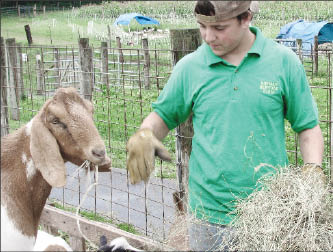 |
|
Goat-to guy: Jeremy Barker, with Easter Seals Work Resource Center, feeds goats at Gorman Heritage Farm in Evendale, Ohio, where he worked last summer. Photo: Southwest Ohio Region Workforce Investment Board |
When Uncle Sam threw a $1.2 billion fastball last spring in the form of a summer jobs program that had to be up and running in a short amount of time, most sites got a base hit, but they didn’t knock it out the park.
That’s one impression given by Reinvesting in America’s Youth: Lessons from the 2009 Recovery Act Summer Youth Employment Initiative, a newly released evaluation of the Recovery Act-funded summer jobs program, which reveals how sites often had to compromise on things like innovation because the deadlines were so tight for implementing the summer programs.
Finding the best employment match for the 345,000 youths who enrolled in the program – 314,000 of whom were placed in summer jobs – proved to be an elusive goal, says the evaluation by Mathematica Policy Research.
With no federal funding set yet for a summer jobs program this year, some summer youth employment administrators believe doing an effective job again this summer could be impossible.
“If they [members of Congress] wait much longer, they will make it practically impossible to implement the program,” laments Sherry Marshall, president of the Southwest Ohio Region Workforce Investment Board, which served 660 youths last summer.
Among other problems, Marshall said, unless federal procurement procedures are waived, startup dates could be pushed into August – when school is about to resume – making programs impractical.
Pairing youths with private employers – cited as a challenge in the Mathematica evaluation – also proved difficult for Marshall’s workforce investment board, which includes Cincinnati.
“It’s challenging to be innovative, because when you have a short amount of time, you have to go with somebody you already know that you can ask to do something in an already quick time frame,” Marshall said. “You don’t have time to go with new employers to try something new.”
Despite the time constraints and other challenges, Marshall says her workforce investment board was able to secure some high-quality job placements for youths, such as clearing honeysuckle and other undergrowth from acres of park land to allow creation of walkways and bike trails. She said some youths who worked last summer at the Harriet Beecher Stowe museum in Cincinnati have decided to study archival history in college.
Whether such feats can be replicated again this summer remains to be seen.
Lessons
The Mathematica evaluation of the 2009 summer jobs program found that sites struggled with a number of issues, including:
• Enrollment and eligibility determination. “Staff across all sites struggled to handle the increased volume of youth, particularly the process of determining their eligibility,” a task the evaluation recommends be handled by more experienced staff members in conjunction with schools and social service agencies.
• Green jobs. The evaluation states that sites often did not use a common definition for green jobs, and some sites were confused about the definition, a problem that could be remedied by additional federal guidelines.
• Measurement of increases in work readiness. “Sites varied dramatically in their measurement of work readiness increases among youth and sometimes used different approaches within a site,” the evaluation states. It called for more federal guidance on the matter. “These inconsistencies make it difficult to assess the true meaning of the national performance measure.”
Despite the challenges cited in the evaluation, youth employment advocates emphasized its positive findings.
Jonathan Larsen, a policy expert at the National Youth Employment Coalition, said the best takeaway points from the Mathematica evaluation are its findings that despite the tremendous pressure of swiftly getting programs up and running, most sites did so without any major problems, successfully recruited youths, and helped 82 percent of participating youths successfully complete their work experiences, with most of them showing an increase in work readiness.
Larsen pointed out that the evaluation also found that the summer jobs program achieved what it describes as a “threefold effect”: Getting money into the hands of poor families, enabling them to spend the money in a depressed economy, and providing them with valuable and sometimes innovative work experience.
“Although the study was unable to assess how meaningful youth experiences were or how their experiences could affect them and their communities over time,” the evaluation states, “site visits revealed interesting, creative, and innovative activities.”
The study can be found at http://wdr.doleta.gov/research, or by searching for “youth summer jobs” at http://www.youthtoday.org.





























